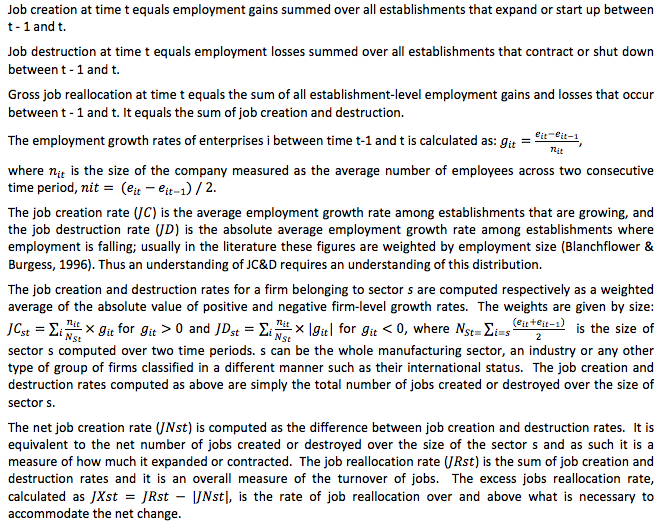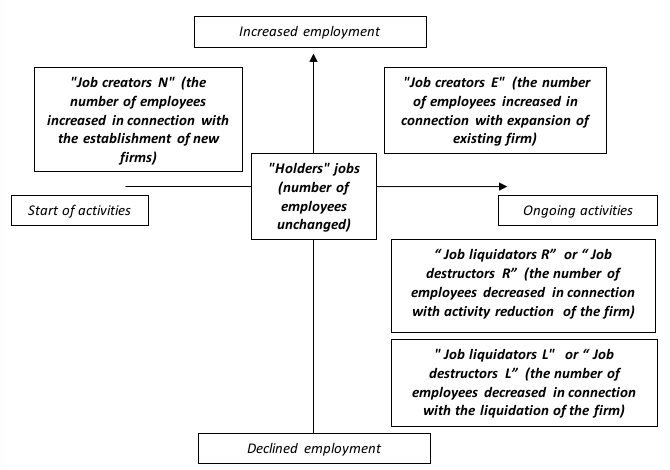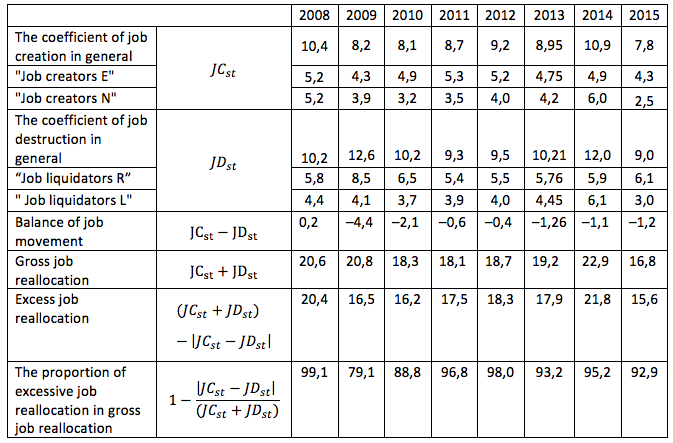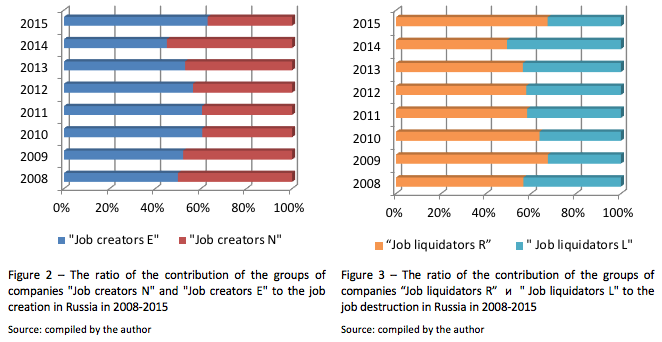

Vol. 39 (# 09) Year 2018. Page 30
Svetlana V. LOBOVA 1
Received: 18/10/2017 • Approved: 25/11/2017
ABSTRACT: The economies of all countries, without exception, experience various turbulences related to jobs every year. Every year new companies appear on the market, while others disappear. Every year operating enterprises reduce or increase the number of jobs. The consequences of such phenomena are the redistribution of workers, capital from less productive companies to more productive ones. In this paper, we generalize and analyze data on the creation and destruction of jobs in Russia, which were obtained by their open sources. Analysis of the causes of creation and destruction of jobs is a very important research topic for Russia, since this phenomenon is a factor in increasing labor productivity. |
RESUMEN: La economía de todos los países, sin excepción, la experiencia de diversas turbulencias relacionadas con el trabajo cada año. Cada año aparecen nuevas compañías en el mercado, mientras que otras desaparecen. Todos los años las empresas operan. Las consecuencias de tales fenómenos son la redistribución de los trabajadores, el capital de las empresas productivas menores. En este documento, generalizamos y analizamos datos sobre la creación y destrucción de empleos en Rusia, que fueron obtenidos por sus fuentes abiertas. El análisis de las causas de creación y destrucción de empleos es un tema de investigación muy importante para Rusia, ya que este fenómeno. |
There are high levels job-to-job movements and flows between employment and unemployment in developed countries. Catalysts of these flows are, on the one hand, events and circumstances that encourage workers to change jobs and companies-employers, on the other hand, events that redistribute jobs between the companies. The movement of workers between workplaces and employers due to career opportunities, migration of family members, job satisfaction, gaining new knowledge, competencies and qualifications. Structural and quantitative change of workplaces takes place under the influence of forces affecting the spatial distribution of labour demand (growth or decline of the markets), restructuring of companies and industries, changes in the structure of internal and external competition, as well as changing the state of the business environment and technological progress. These forces are driven by job creation and destruction, which in turn cause workers to change employers and to shuffle between employment and unemployment. The replacement of less productive and technologically obsolete jobs more efficient and modern making a significant contribution to the growth of aggregate productivity. Thus the movement (creation and destruction) of jobs is the basis of any structural changes in modern economies. The importance of job creation (and destruction) in an economy cannot be overstated (Davis, Haltiwanger & Schuh, 1996).
The study of job flows is very important for Russia. Currently, the productivity Russia lags behind leading countries (table 1). As established, reallocate jobs at intra-firm level (from less effective to more effective) and interfirm level (from less productive businesses to more productive businesses) entails productivity growth at the macroeconomic level.
Table 1
Dynamics of changes in labor productivity in countries
(GDP per hour worked, constant prices, 2010 PPPs, US dollars)
Country |
1995 |
2000 |
2005 |
2010 |
2011 |
2012 |
2013 |
2014 |
2015 |
2016 |
Luxembourg |
72,6 |
78,8 |
80,8 |
79,8 |
79,5 |
77,7 |
79,7 |
81,7 |
82,5 |
83,6 |
Ireland |
34,7 |
44,4 |
51,7 |
58,3 |
63,9 |
64,1 |
63,1 |
66,7 |
81,3 |
83,2 |
Norway |
64,5 |
71,9 |
80,6 |
76,7 |
76,1 |
76,7 |
77,2 |
77,6 |
78,7 |
79,1 |
Denmark |
51,5 |
54,8 |
58,6 |
60,3 |
60,5 |
61,6 |
62,1 |
63,1 |
63,4 |
63,5 |
United States |
44,8 |
50,4 |
57,1 |
61,9 |
62,1 |
62,2 |
62,3 |
62,5 |
62,9 |
63,3 |
Netherlands |
48,9 |
54,2 |
58,2 |
59,4 |
59,8 |
59,7 |
60,1 |
60,5 |
61,5 |
61,7 |
France |
47,7 |
52,2 |
56,0 |
57,0 |
57,5 |
57,6 |
58,4 |
58,9 |
59,4 |
60,0 |
Germany |
46,0 |
50,6 |
54,4 |
56,3 |
57,5 |
57,8 |
58,3 |
58,5 |
59,0 |
59,5 |
Austria |
39,3 |
44,9 |
51,8 |
53,1 |
53,5 |
53,4 |
53,9 |
54,5 |
55,8 |
56,3 |
United Kingdom |
36,8 |
41,0 |
45,6 |
41,1 |
47,2 |
46,9 |
46,9 |
47,1 |
47,8 |
47,9 |
Italy |
44,9 |
47,3 |
47,1 |
47,2 |
47,5 |
47,3 |
47,8 |
47,8 |
47,7 |
47,4 |
New Zealand |
30,2 |
32,1 |
33,8 |
35,9 |
36,6 |
37,9 |
37,2 |
36,3 |
37,5 |
37,8 |
Turkey |
20,4 |
23,1 |
28,4 |
30,7 |
32,4 |
33,1 |
35,3 |
35,4 |
36,4 |
36,9 |
Russia |
15,0 |
15,3 |
19,5 |
22,9 |
23,5 |
24,2 |
24,7 |
24,7 |
23,9 |
23,8 |
Source: http://stats.oecd.org/index.aspx?DatasetCode=PDB_LV
The purpose of this article is to quantify the movement of jobs in the Russian labor market. To do this, it focuses not on changes in employment, but on the simultaneous job creation and job destruction (JC&D).
The problem of mobility in the labour market is impossible without a common methodology to calculate job turnover and labor. The framework methodology analysis of flows in the labour market was first described by Davis and Haltiwanger (1991). The methodology is universally accepted among economists all over the world and is used in statistical recording of changes in the labor market of many countries. For example, the Bureau of Labor Statistics (BLS) regularly publishes relevant data by region and activity, based on the Davis- Haltiwanger methodology (hereinafter referred to as MDH): http://www.bls.gov/bdm/home.htm (Gimpelson, Kapelyushnikov & Ryzhikova, 2012). MDH has an interdisciplinary nature, since the research is supposed to be carried out at the "junction" between the labor economy (labor movement) and the firm's theory (job movement).
The analysis of movement of workplaces on the basis of MDH allows:
- consider various models of employers' behavior in the labor market. You can assess what the behavior of the employer is, creative or liquidation, depending on the parameters: internal (the age of the firm, the number of employees) and - external: region, industry, state of the economy;
- to assess the "growing" / "extinct" sectoral labor markets. We can assume that having learned about the establishment and liquidation of the industry, we will be able to assess the dynamics of the industry, to trace the relationship with labor productivity;
- when analyzing, it is not just the availability of vacancies that should be taken into account, but their actual filling.
Accounting for the movement of jobs in Russia is carried out by Rosstat on the basis of its own methodology. It is based on the following key approaches, which are presented in Tab. 2 in comparison with the MDH principles and the BLS’s methodology (http://www.bls.gov/bdm/bdmover.htm#concepts) .
Table 2
The components of Rosstat's approach to the assessment of the job movement
The components of Rosstat's approach |
Does it comply with MDH principles? |
A job is an explicit or implicit contract concluded between an employee and an employer to perform a specific job in exchange for a payment or a mixed income |
Yes |
The job is an occupied position, and not an open vacancy, therefore not only employees of the payroll staff are considered, but also external part-timers and persons engaged under civil law contracts |
Yes |
All employees of the company participate in determining the movement of jobs, but their accounting depends on the mode of work in the occupied jobs, i.e. when determining the average number of employees (and hence the number of replaced jobs), the categories of employees are taken into account not as whole units, but in proportion to the time worked by them |
No |
Covering all types of economic activity in the segment of large and medium-sized companies that form the core of the modern Russian economy |
No |
The indicator of job creation and destruction is determined on the basis of the average number of employees for the observed period - month, quarter, year |
Yes |
Source: compiled by the author
Thus, the initial data for writing this paper were the Rosstat’s data on the job movement on the Russian labor market, collected in accordance with the described methodology.
In the developed economies arises up about 10-15% of new workplaces (in relation to a total number all busy in all companies) and disappears approximately so much " old" annually .
The movement of jobs this is a permanent flow of creation and destruction of jobs in period t relative to period t-1. The details of constructing job creation and destruction series (and caveats about them) are described in Ritter (1993). Davis and Haltiwanger (1998) provide the following definitions of key concepts:

To investigate the reallocation of jobs between different groups of firms, it is possible to decompose the surplus total job reallocation into the components of intra- and inter-group changes. If the groups of firms are defined according to their international status, the latter provides a measure of the reallocation of jobs between firms participating and not participating in international markets. The ‘between’ and ‘within’ components can be computed as:
The job creation and destruction have two sources: the first - the expansion or reduction of employment in operating companies, the second - the entry of new, previously non-existent companies, or the liquidation of operating companies. Operating companies dismiss and hire employees, thereby moving jobs and employees. And the processes of dismissal and hiring of workers, as a rule, proceed in parallel. Disappearing from the market, the company destructed a large number of obsolete jobs, while newly established companies usually create more productive jobs. This thesis is confirmed by studies of Griliches and Regev (1995), Disney, Haskel and Heden (2003).
All companies operating on the labor market are divided into five groups, which are correlated with the coordinate system (Fig. 1)
Figure 1
Classification of companies in terms of job creation and destruction

Source: compiled by the author
Russian work, which is described in detail Rosstat’s methodology for measuring job flows, is Gimpelson, Kapelyushnikov & Ryzhikova (2012). The increase in the average number of employees in companies belonging to "Job creators N" and "Job creators E" groups shows the number of employees created, while the decrease in the average number of employees in the companies belonging to “Job liquidators R” and " Job liquidators L" reflects the number of jobs eliminated in the economy.
Which of the two factors – turnover jobs in existing companies or the creation of new companies and liquidation and termination of activities of the companies is more important in the process of reallocation jobs? According to the project “The European Map of Job Flows,” on average, the countries with the developed market and transition economies the contribution of the creation and liquidation of firms is 27% of the total turnover of jobs, and especially the significant contribution of companies in liquidation jobs, where this figure reaches 36% (Martin-Barroso and Andres, 2011). Similar results were obtained OECD experts who have studied the movement of jobs in OECD countries. A third of all jobs created and about 30% of jobs created are associated with the process of occurrence and liquidation of new companies (OECD Employment Outlook, 2009).
The data characterizing the job and labor force movement in 2008-2015 on the Russian labor market are presented in Tab. 3.
Table 3
Dynamics of the job and labor force movement
(in large and medium-sized companies) in Russian Federation in 2008-2015, thousands of people
|
2008 |
2009 |
2010 |
2011 |
2012 |
2013 |
2014 |
2015 |
Average number of replaced jobs during the year |
39314 |
37579 |
36728 |
36342 |
36108 |
35724 |
35218 |
34729 |
Number of created jobs during the year (gross job creation) |
4079 |
3091 |
2983 |
3174 |
3304 |
3198 |
3835 |
2367 |
"Job creators E" |
2037 |
1614 |
1808 |
1921 |
1869 |
1698 |
1731 |
1491 |
"Job creators N" |
2042 |
1476 |
1175 |
1252 |
1435 |
1500 |
2104 |
876 |
Number of job destructed (gross job destruction) |
4010 |
4725 |
3735 |
3386 |
3439 |
3647 |
4219 |
3135 |
“Job liquidators R” |
2272 |
3190 |
2383 |
1974 |
1992 |
2058 |
2081 |
2115 |
" Job liquidators L" |
1738 |
1535 |
1352 |
1412 |
1448 |
1589 |
2137 |
1021 |
Change in the number of replaced jobs (increase or decrease) compared to the previous year (net employment change) |
+69
|
–1634 |
–753 |
–212 |
–135 |
–449 |
–384 |
–768 |
Source: The Russian Labor Market, 2017
In the period 2008-2015 Russian large and medium-sized companies reduced the number of employees from about 39.3 million to 34.7 million people. On average over the year they created about 3-4 million new jobs due to the expansion of employment in some enterprises and about the same amount were eliminated by reducing them to others. Thus the total number of jobs that were redistributed annually (the amount of created and liquidated) jobs fluctuated within 6.5-8 million, but starting in 2009, the difference (created and liquidated) was always negative.
The data in Tab. 3 allows us to calculate the relative indicators of the creation and elimination of jobs, expressed as a fraction of the average employment.
Table 4
The coefficients of the dynamics of job and labor force movement (in large and
medium-sized enterprises) in the labor market of the Russian Federation in 2008-2015

Source: The Russian Labor Market, 2017
To draw conclusions about which companies (existing or newly formed) contribute more to the creation of jobs, we will analyze Fig. 2.

Figure 2 shows that more "new" companies contribute more to creating jobs, with the exception of 2014, when the increase in jobs was due to the expansion of the scale of activity of existing companies. This cyclicality in the processes of creating jobs is synchronous with the dynamics of GDP. If we translate the absolute values into relative figures (in% of the total number of jobs), then we see a decrease from 10% to 8% at the beginning of the period, then stabilization at 8-9%, growth to 11%, and finally a decrease to 7% (The Russian Labor Market, 2017).
This finding correlates with the results of foreign researchers (for example, Mortensen & Christopher, 1994). Existing firms have good information about the profitability of new differentiated products within their sectors, so a natural assumption to make is that new jobs are more productive than existing ones (Mortensen & Christopher, 1994). It should be understood that the job creation occurs when a company with a vacant job and an employee meets and begins to produce; the opening of a new vacancy is not the job creation, but only the potential employment creation.
The maximum number of jobs (4.7 million) was withdrawn in the crisis year 2009, then during 2010-2013 the number of liquidated positions did not reach 3.8 million per year. A new high was achieved in 2014, when 4.2 million jobs "left". However, in 2015 the liquidation process slowed down dramatically (The Russian Labor Market, 2017). Fig. 3 shows the contribution to the liquidation of the jobs of the groups of companies "Job liquidators R" and "Job liquidators L". As in the situation with the creation, the largest contribution to the elimination of jobs is made by existing companies. This circumstance confirms the thesis about the parallelism, but not the symmetry of creation and destruction of jobs in operating companies. Fig. 4 shows the difference between destructed and created jobs in existing Russian companies.
Figure 4
The difference between destructed and created jobs in existing companies in Russia in 2008-2015

Source: compiled by the author
Fluctuations in terms of creating and eliminating jobs can occur under the influence of two factors: firstly, changes in the ratio between the number of manufacturing enterprises and the number of liquidator enterprises and, secondly, through the acceleration or slowing down on them of the processes of creating and liquidating workers places (rate or increase, or reset employment) (The Russian Labor Market, 2017).
This paper describes the movement of jobs in the Russian labor market using open statistics and research results of scientists from the Higher School of Economics (Moscow).
The impossibility of further disaggregation of the available indicators, incomplete coverage of economic operators and a short duration of the time series are significant limitations for making larger conclusions and conclusions. However, the available data allow us to record important trends in the field of job movement and provide the basis for further analysis.
BLANCHFLOWER, David G., and Simon M. BURGESS. Job creation and job destruction in Great Britain in the 1980s. Industrial and Labor Relations Review, 1996, Vol. 50, No. 1, pp. 17-38. Retrieved from: https://dspace.stir.ac.uk/bitstream/1893/10208/1/Blanchflower_1996_Job_creation_and_job_destruction.pdf
CAHUC, P. Search, flows, job creations and destructions. Labour Economics, October 2014, vol. 30, pp. 22–29.
DAVIS, Steven J., and John HALTIWANGER. Gross Job Creation, Gross Job Destruction and Employment Reallocation (June 1991). NBER Working Paper, 1991, no. w3728. Retrieved from: http://www.nber.org/papers/w3728.pdf
DAVIS, Steven J., and John HALTIWANGER. Measuring Gross Worker and Job Flows. In: Labor Statistics Measurement Issues. University of Chicago Press, 1998, pp. 77 – 122.
DAVIS, S. J., and J. C. HALTIWANGER, and S. SCHUH Job Creation and Destruction. MIT Press, Cambridge, MA and London, 1996. Retrieved from: http://www.roiw.org/1997/253.pdf
DISNEY, R., and J. HASKEL, and Y. HEDEN. Restructuring and Productivity Growth in UK Manufacturing. Economic Journal, 2003, vol. 113, pp. 666-694.
GRILICHES, Z., and H. REGEV Firm Productivity in Israeli Industry: 1979–1988. Journal of Econometrics, 1995, vol. 65, pp. 175-203.
GIMPELSON, V.E., and R.I. KAPELYUSHNIKOV, and Z.A. RYZHIKOVA. Movement of jobs in the Russian economy: in search of creative destruction : preprint WP3 / 2012/03. Nat. Issled. University Higher School of Economics. M Moscow: Publishing House of the Higher School of Economics, 2012. Retrieved from: https://www.hse.ru/data/2012/04/05/1251237418/WP3_2012_03.pdf
MARTIN-BARROSO, D., and J. ANDRES. The European Map of Job Flows. Munich PersonalRePEc Archive, 2011, pp. 1-188.
MORTENSEN, Dale T., and A. CHRISTOPHER. Job Creation and Job Destruction in the Theory of Unemployment. The Review of Economic Studies, Vol. 61, No. 3 (Jul., 1994), pp. 397-415
OECD Employment Outlook. OECD, Paris, 2009, рр. 117-157.
RITTER, Joseph A. Measuring Labor Market Dynamics: Gross Flows of Workers and Jobs. Federal Reserve Bank of St. Louis Review, 1993, 75 (6), pp. 39-57.
THE RUSSIAN LABOR MARKET: TRENDS, INSTITUTIONS, STRUCTURAL CHANGES. Report of the Center for Labor Studies and Laboratories of Labor Market Research, HSE, Ed. V. Gimpelson, R. Kapelyushnikov, S. Roshchin. Moscow: Publishing House of the Higher School of Economics, 2017.
1. Altai State University. Department of Personnel Management and Socio-Economic Relations. Barnaul, Russia.
Ural State University of Economics. Department of Labor Economics and Personnel Management. Ekaterinburg, Russia. E-mail: barnaulhome@mail.ru